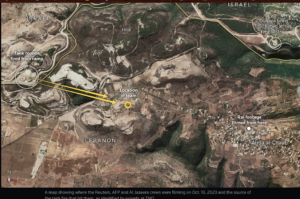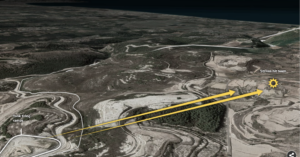In journalism, every story must answer five fundamental questions known as the 5 W’s: “Who,” “What,” “When,” “Where,” and “Why,” with “How” usually added as number 6. These are the basic pillars that help build a reliable and coherent picture of reality.
Yet Reuters’ impressive investigative report into the killing of the agency’s journalist Issam Abdallah in south Lebanon last October focuses heavily on all these questions except for the “Why.” Thus, it omits crucial context from what is undoubtedly a tragic incident and frames it as a deliberate Israeli action against reporters.
Forensic Expertise
Abdallah was killed while covering cross-border fire near the Israel-Lebanon border on October 13, several days after Lebanese terror group Hezbollah started launching rockets at Israel in solidarity with the deadly Hamas attack that sparked the Israel-Hamas war on October 7.
According to the IDF, which has repeatedly said it does not deliberately target journalists, the incident has been under review since then.
But Abdallah’s colleagues, led by Reuters bureau chief for Lebanon, Syria and Jordan, Maya Gebeily, didn’t wait for any review. They apparently decided they were knowledgeable enough to collect all relevant forensic evidence from the scene in order to find the culprit.
Indeed, it is legitimate to cast doubt on these journalists’ forensic expertise (particularly if they had only 6-7 minutes to collect material from the site as Gebeily later acknowledged), and on their objectivity as bereaved friends who had just lost their beloved colleague. But it seems like they have made a serious effort.
They used every piece of shrapnel they could put their hands on, spoke to witnesses and experts, and even cross-referenced their data with audio recordings of the lethal strike caught on live television. All evidence was then transferred to a Dutch research organization for an independent analysis, Reuters said.
Related Viewing: No Quiet on Israel’s Northern Front
Omitting Hezbollah
Reuters’ investigative report from December 2023 covered the organization’s initial findings, and another report revealed its final results last week. In both cases, the conclusion was that Abdallah had been killed by Israeli tank fire.
While this may very well be true, it’s not the point.
The point is that amid all the painstaking details about the strike that killed Abdallah — the 120 mm rounds that came from “1.34 km away in Israel,” followed by “fire from 0.50 caliber rounds of the type used by the Browning machine guns that can be mounted on Israel’s Merkava tanks” — Reuters missed the forest for the trees and minimized the reason Israel was firing across the border in the first place: Hezbollah.
In Reuters’ investigative report, detailed maps completely omit the terror group’s presence at the border area. They make it look like Israel was firing in a vacuum directly at the group of journalists that included Abdallah — and not, perhaps, towards Hezbollah rocket launchers.
Disturbingly, there is a caption that reads “hills” on the map, as if this is a more crucial detail to know rather than the presence of armed terrorists:


Shouldn’t such an investigative effort include some looking into Hezbollah’s positions around those hills?
Particularly because Reuters’ text does mention the IDF’s claim that there have been reports on a terrorist infiltration that day — so couldn’t Gebeily’s hard-working team make an effort to include some graphic expression of that on the map?
After all, a picture — or in this case a map — is worth a thousand words.
But words can also mislead, as they do in Reuters’ report on the Dutch organization’s final findings, which mentions Hezbollah only once — in the 8th paragraph, as part of the IDF response. It’s also mentioned only 4 times in the investigative piece.
For comparison sake, a Reuters special report on the killing of an agency’s photographer in Afghanistan in 2021 mentions the Taliban 41 times.
And, unlike the report on Abdallah’s killing that ends with a condemnation from Reuters’ Editor-in-Chief and her call on Israel “to explain,” the Afghanistan report does not include any condemnation nor a call to hold anyone responsible.
Again, it’s important to ask “Why?”
Why was Hezbollah omitted from the maps in Reuters’ investigative report and hardly mentioned in its coverage of the final findings?
Why was so much work invested in telling only half the story?
And why does Reuters seem to have different reporting standards when it comes to Israel?
Liked this article? Follow HonestReporting on Twitter, Facebook, Instagram and TikTok to see even more posts and videos debunking news bias and smears, as well as other content explaining what’s really going on in Israel and the region.
Image credit: Reuters/Google © 2023 Airbus, Maxar Technologies


